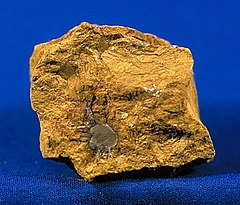Limonite
| Limonite | |
|---|---|
 |
|
| General | |
| Category | Amorphous, mineraloid |
|
Formula (repeating unit) |
FeO(OH)·nH2O |
| Strunz classification | Unclassified |
| Identification | |
| Color | Various shades of brown and yellow |
| Crystal habit | Fine grained aggregate, powdery coating |
| Cleavage | Absent |
| Fracture | Uneven |
| Mohs scale hardness | 4 - 5½ |
| Luster | Earthy |
| Streak | Yellowish brown |
| Diaphaneity | Opaque |
| Specific gravity | 2.9 - 4.3 |
| Density | 2.7 - 4.3 g/cm3 |
| References | |
Limonite is an iron ore consisting of a mixture of hydrated iron(III) oxide-hydroxides in varying composition. The generic formula is frequently written as FeO(OH)·nH2O, although this is not entirely accurate as the ratio of oxide to hydroxide can vary quite widely. Limonite is one of the two principal iron ores, the other being hematite, and has been mined for the production of iron since at least 2500 BCE.
Limonite is named from the Greek word for meadow (λειμών), in allusion to its occurrence as bog iron ore in meadows and marshes (reference is here needed, since one may rather see it originating in the Latin "limus" - which means mud - or in its yellowish lemon-like color). In its brown form it is sometimes called brown hematite or brown iron ore. In its bright yellow form it is sometimes called lemon rock or yellow iron ore.
Limonite is relatively dense with a specific gravity varying from 2.7 to 4.3. It varies in colour from a bright lemony yellow to a drab greyish brown. The streak of limonite on an unglazed porcelain plate is always brownish, a character which distinguishes it from hematite with a red streak, or from magnetite with a black streak. The hardness is variable, but generally in the 4 - 5.5 range.
Although originally defined as a single mineral, limonite is now recognized as a mixture of related hydrated iron oxide minerals, among them goethite, akaganeite, lepidocrocite, and jarosite. Individual minerals in limonite may form crystals, but limonite does not, although specimens may show a fibrous or microcrystalline structure, and limonite often occurs in concretionary forms or in compact and earthy masses; sometimes mammillary, botryoidal, reniform or stalactitic. Because of its amorphous nature, and occurrence in hydrated areas limonite often presents as a clay or mudstone. However, there are limonite pseudomorphs after other minerals such as pyrite. This means that chemical weathering transforms the crystals of pyrite into limonite by hydrating the molecules, but the external shape of the pyrite crystal remains. Limonite pseudomorphs have also been formed from other iron oxides, hematite and magnetite; from the carbonate siderite and from iron rich silicates such as almandine garnets.
...
Wikipedia
